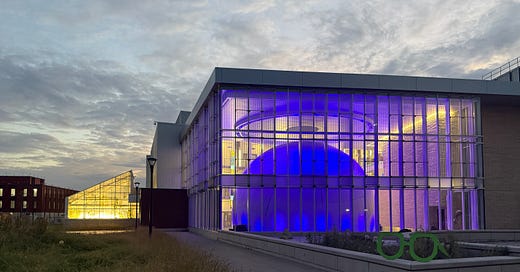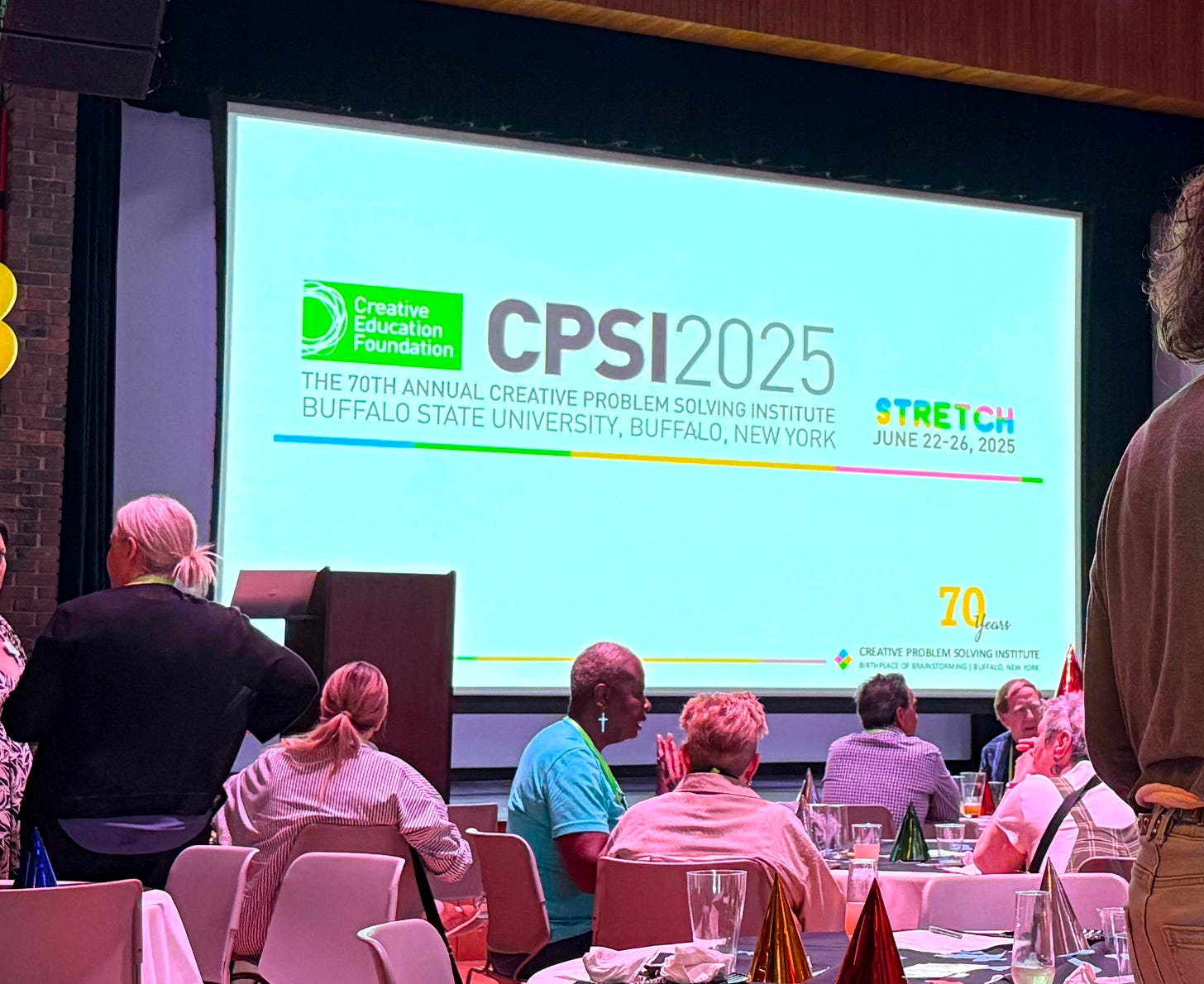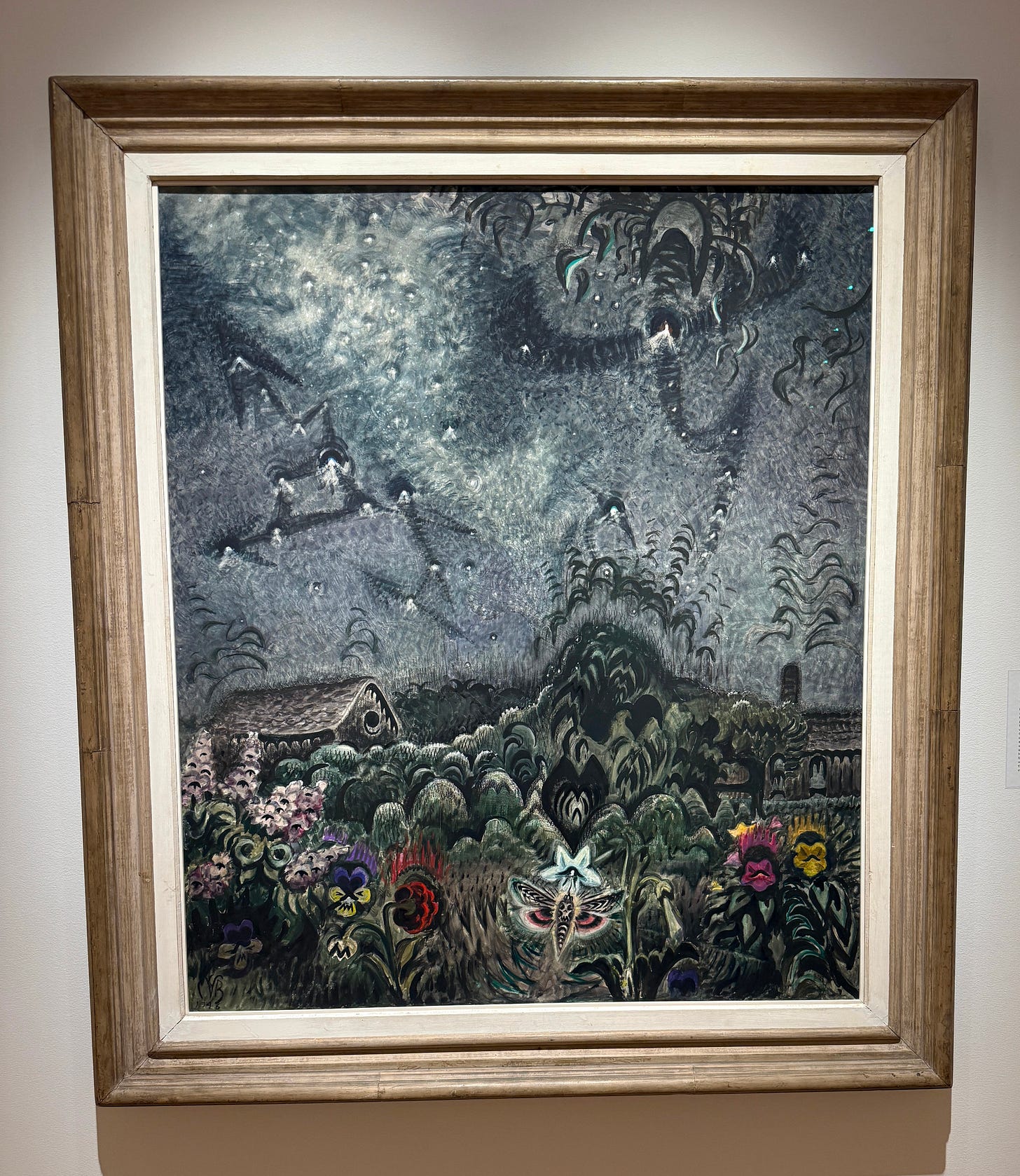Creative Problem Solving for Change: Lessons Anyone Can Use from CPSI 2025
Last week, I attended the five-day Creative Problem Solving Institute (CPSI) at Buffalo State University in Buffalo, NY, organized by the Creative Education Foundation. CPSI is a renowned creativity conference designed to immerse participants in learning, connection, and creation. Beyond classes and workshops, the experience includes shared meals, social events, opportunities for reflection, and plenty of networking—a vibrant, holistic environment to explore creativity and innovation.
Each morning featured a Main Track course. Participants chose one to attend for four days, followed by afternoons filled with breakout sessions, networking, and special events. I chose the Core CPS Track, which focused on the Foundations of Creative Problem Solving (CPS)—a structured method for developing innovative, actionable ideas.
Foundations of Creative Problem Solving
In the Core CPS Track, the mornings were dedicated to understanding the CPS framework: Clarify, Ideate, Develop, and Implement.
Clarify: When you clarify, you name what is true. This shuts down emotive spirals that flourish in your brain.
Ideate: When you ideate, you invite hope with possibility thinking facilitated by invitational stems (I wish, Wouldn’t it be great if).
Develop: When you develop, you calm the nervous system by replacing ambiguity with a thoughtful plan.
Implementation: When you implement, you take decisive action, which transforms mental stress into purposeful movement.
This approach helps us remain regulated—even in high-stakes or stressful situations—by providing a reliable path out of panic toward meaningful problem solving.
We also discussed concepts such as the Forgetting Curve, first described by Hermann Ebbinghaus, which illustrates how memory declines rapidly unless knowledge is reinforced. We talked about Affirmative Judgment, emphasizing the power of positive framing.
A highlight was taking the FourSight preference test to uncover our natural thinking styles in the problem-solving process. I discovered I am a Driver, leaning toward ideation and implementation. As FourSight researchers have found, solving complex problems well requires all four preferences—even though most people favor just one.
To see your own preferences, you can try the abridged New York Times quiz: What Kind of Thinker Are You?.
Importantly, we learned the power of divergent and convergent thinking. Divergence is about expanding the field of possibilities without judgment—generating many ideas freely. Convergence is about narrowing those ideas thoughtfully, selecting the most promising, and planning their development. CPS teaches us to keep these two modes deliberately separate, preventing premature critique from shutting down creativity and ensuring our final solutions are both imaginative and practical.
We also practiced reframing our thoughts and communication using invitational stems like I wish, How might we, or It would be great if—shifting our mindset to possibility thinking. This mindset is further encouraged by using deferred judgement—responding to suggestions with Yes, and… instead of saying no or shutting down ideas without exploration. Sometimes nuggets of truth and useful tools for progress can be found in even the wildest ideas. Using invitational stems and affirmative judgement allows us to sit in the messiness of a conversation or thought while we discover together what may be useful.
One of CPSI’s greatest strengths is its emphasis on low-stakes practice in a supportive environment, helping us become more resilient and effective in the high-stakes challenges we face after the conference.
Step Into: LEGO® Serious Play® (LSP) Methods
One afternoon session introduced LEGO Serious Play (LSP), a hands-on methodology that encourages building, sharing, and reflecting to unlock creative thinking.
We learned that 70–80% of our brain is connected to our hands. This “hand knowledge” lets us access deeper insights by doing, not just talking.
LSP builds on Mihaly Csikszentmihalyi’s work on Flow, the state achieved when challenge and skill are in perfect balance. Once in flow, anxiety and boredom fall away.
Despite initial skepticism, our group discovered surprising insights about our own thinking. LSP isn’t just child’s play; it’s used to break unproductive organizational narratives and develop strategy. For example, the Swiffer mop was famously developed using LSP techniques.
We played What the Duck, an LSP exercise using six LEGO bricks to build a duck in countless different ways.
The What the Duck Lego Serious Play activity highlights the power of play and simple materials in fostering communication, collaboration, and creative problem-solving within a team. – David Kubacki
If you’re curious, David Kubacki’s TEDx talk is a great introduction.
Be an Illuminator! and The Creative Path to Belonging
Two workshops focused on bringing out the best in others by fostering belonging and psychological safety. We explored how to avoid being diminishers and instead become illuminators:
The short definition of an illuminator is someone who has deep reverence for the individuality of a person and the ability to create a safe space for that person to feel seen.
Key themes included:
· Genuine Curiosity – asking open-ended questions and showing interest
· Active Listening – tuning in to both words and emotions
· Expressing Appreciation – hearing what isn’t being said
These ideas echo David Brooks’ reflections on social connection and listening in The Essential Skills for Being Human as well as his book How to Know a Person: The Art of Seeing Deeply and Being Deeply Seen.
Creative Abundance: Seeds for Shifting Lenses
This workshop invited us to consider areas of our lives where we experience scarcity or we wish for more abundance, then to reflect on what is already abundant—even in those spaces. This exercise was a practice in gratitude, in seeing what is already present in abundance, even in areas of our lives where we may wish for something different.
We divided into groups of three, rotating roles of speaker, listener, and scribe, echoing the Indigenous concept of the Three Sisters (corn, beans, squash) that grow best together.
We also practiced forest therapy or Shinrin-yoku, a mindful immersion in nature. We each found an artifact in nature that symbolized our personal story of scarcity and abundance, then released it collectively in a ritual of letting go, followed by a meditation focused on deep listening to the surrounding sounds.
Forest therapy, also known as forest bathing or Shinrin-yoku, is a mindful practice of immersing oneself in nature, particularly forests, to promote physical and mental well-being.
Author Talk with Zorana Pringle, Ph.D.
We attended an Author Talk with Dr. Zorana Ivcevic Pringle from Yale University as she premiered her book:
The Creativity Choice: From Having Ideas to Making them Happen
She discussed emotional intelligence (EQ) and regulation, drawing on her research into how emotions shape our creative choices, the psychological risks involved (intellectual, reputational), and how to manage frustration and doubt.
She explained that weak ties help generate ideas thanks to diverse perspectives, while strong ties help develop them. She also shared evidence that leaders with high EQ foster more creative, fulfilled teams.
Dr. Pringle’s insights reinforced that creative work is deeply social and built on managing risk, ambiguity, and emotion.
Reflect, Engage, Inspire: Stretching Your Facilitation Toolbox
This session, led by Kim Macuare, PhD, was held at the Burchfield Penney Art Center on campus. We explored how contemplative practices can deepen engagement, sharpen focus, and inspire new ways of understanding. Through hands-on activities involving writing, drawing, and close observation, we learned strategies to slow down and truly see what is in front of us.
Contemplative pedagogy emphasizes the quality of attention over the quantity of content. Instead of racing through information, we practiced pausing to notice, reflect, and connect on a deeper level.
Our first exercise (above) invited us to choose a piece of art that spoke to us, then spend time noticing what was interesting, strange, or revealing. I gravitated toward Nancy Belfer’s Sentinel Series [Ceremonial] (1983), drawn to its near-symmetry that felt like an echo across generations—a reminder that harmony and reciprocity can exist without sameness. Life reflects onto us with subtle changes and new information.
Next, we chose another piece to write a postcard from—as if we were inside the artwork itself, describing it to someone far away. I selected The Sphinx and the Milky Way (1946) by Charles E. Burchfield (1893–1967). The painting’s mysterious, luminous quality, with its cosmic sweep and dreamlike landscape, invited me to imagine being immersed in its world. In just a few minutes, I wrote:
Greetings from the night garden!
This place is magical. I’m immersed in a colorful world of flowers and vines, buzzing and humming with life. New growth emerges in the darkness of night. Vivid hues and blissful summer scents illuminate the night. The sky sparkles and shimmers like mica. It too is alive with shooting stars and dragon flies. Hope to meet you here, if only in our dreams!
We also explored synesthesia exercises, emotional mapping, and Visual Thinking Strategies (VTS)—asking what’s happening in an image, what details support that interpretation, and what more we might see.
These practices helped us move beyond surface-level looking to truly experience art—and reminded us how we can use the same slowing-down techniques in any area of life to foster insight, empathy, and connection.
Planetarium Experience
One evening we visited the Whitworth Ferguson Planetarium for two shows about space and time. We explored constellations, light pollution, and the idea of International Dark Sky Places:
Areas in the US where light pollution is minimized to allow for optimal stargazing are called International Dark Sky Places, specifically designated by DarkSky International.
Learn more about these spaces: DarkSky International.
Think Neighborly: Using CPS Basics to Build Community
This session turned the lens outward, asking how we can apply CPS principles to reduce polarization and build stronger communities. Drawing on Peter T. Coleman’s The Way Out: How to Overcome Toxic Polarization, we discussed how conflict can move from disagreement toward contempt—cutting off dialogue and understanding.
We learned to counteract this slide with strategies like:
· Deferring judgment
· Listening generously
· Embracing tolerance of ambiguity
We talked about constructive discontent—staying in the messy complexity of real conversations long enough to truly hear one another. By practicing radical curiosity, we can transform disagreements from entrenched battles into shared explorations.
Practical ideas for thinking neighborly included creating spaces for informal, obligation-free connection—hosting potlucks, joining sports practices, community gardening, or starting a book club. These are the places where conversation can thrive, empathy can grow, and communities can heal.
For more on these approaches:
Conference Closing Ceremony and Reflections
When the winds of change blow, some build walls, some build windmills.
This Chinese proverb perfectly captures the spirit of the conference. In a time of rapid change and deep polarization, we have a choice: resist and retreat or harness the winds to power something new.
This week, I learned not just techniques for problem solving, but principles for living and leading with creativity, empathy, and purpose.
We learned to diverge and converge deliberately, balancing expansive thinking with focused action. We practiced inviting possibility with simple reframing of our language. We built ideas with our hands in LEGO Serious Play, reminding ourselves that doing can unlock what talking cannot. We reflected deeply, listened generously, and considered how to be illuminators who see and encourage the best in others.
We examined how creativity is social, built on trust, psychological safety, and emotional intelligence. We saw how even our communities can change if we choose curiosity over contempt, if we hold space for nuance instead of insisting on certainty.
These are not just professional skills—they are human ones.
If we want to see change in our world, we must choose to be the windmills— capturing the energy of these turbulent times and transforming it into momentum for positive, creative action. I hope that you too will consider practicing these lessons, not just for ourselves, but for our families, our neighbors, and our communities.
Change doesn't only happen to us—it happens through us.
Works Cited
Belfer, Nancy. Sentinel Series [Ceremonial]. 1983, Burchfield Penney Art Center, Buffalo.
Brooks, David. How to Know a Person: The Art of Seeing Deeply and Being Deeply Seen. Random House, 2023. https://a.co/d/51GsrVC
Brooks, David. “The Essential Skills for Being Human.” The New York Times, 19 Oct. 2023, www.nytimes.com/2023/10/19/opinion/social-skills-connection.html.
Builders Movement. “What You Can Do.” www.buildersmovement.org/whatyoucando
Builders Movement. “Citizen Solutions.” www.buildersmovement.org/citizensolutions/
Burchfield, Charles E. The Sphinx and the Milky Way. 1946.
“2025 Creative Problem Solving Institute (CPSI).” Creative Education Foundation, www.creativeeducationfoundation.org/event/2025-creative-problem-solving-institute-cpsi/.
“Dark Sky Places.” DarkSky International, www.darksky.org/what-we-do/international-dark-sky-places/
Dignity Index. www.dignity.us/index.
Kubacki, David. What the DUCK? How Playing with LEGO Bricks Can Change How You Inter(act). TEDxCWRU, YouTube, www.youtube.com/watch?v=KtX7226Uhdw.
“LEGO® SERIOUS PLAY®.” FourSight Online, www.foursightonline.com/.
New York Times. “What Kind of Thinker Are You?” The New York Times, 9 Feb. 2014, www.nytimes.com/2014/02/09/education/edlife/what-kind-of-thinker-are-you.html.
Pringle, Zorana Ivcevic. The Creativity Choice: From Having Ideas to Making Them Happen. Yale University, 2025.
University of Chicago News. “Mihaly Csikszentmihalyi, Pioneering Psychologist and Father of ‘Flow,’ 1934–2021.” www.news.uchicago.edu/story/mihaly-csikszentmihalyi-pioneering-psychologist-and-father-flow-1934-2021
Weavers Assessment. www.trust.weavers.org
Bonus hilarity—at the conference, they posted these jokes on the restroom mirrors. I found this one to be particularly funny!














This is really interesting and useful.